|
FAQs about Stony Coral, Cnidarian
Identification 13
Related FAQs: Stony Coral ID 1, Stony Coral ID 2, Stony Coral ID
3, Stony
Coral ID 4, Stony Coral ID 5,
Stony Coral ID 6, Stony Coral ID 7, Stony Coral ID 8, Stony Coral ID 9, Stony Coral ID 10, Coral ID 11, Stony Coral ID 12, Stony Coral ID 14, Stony Coral ID 15, & Cnidarian
Identification, Stony FAQs 1, Stony
FAQs 2, Foods/Feeding/Nutrition, Disease/Health, Propagation, Coral Compatibility, Stony Coral Behavior,
Related Articles: Stony
Corals,
|
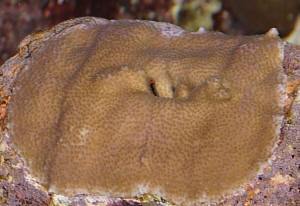 |
|
Possibly help with NPS coral ID, Rhizangiidae
6/19/11
Hi all,
<Deb>
A few months ago I purchased a small rock with some Tubastrea on
it. It looked as though half had the skeletons of young/baby
Tubastrea that had died...until a week or so ago. I normally feed
the sun corals using a flashlight because the black sun corals
close up when I turn the tank light on. But I needed the light
and that's when I noticed these tiny tentacles.
I thought they were orange ball anemones that had 'taken
up' residence in the skeletons but I think that assumption is
wrong. They sort of remind me of pictures I've seen of
Culicia coral. Thanks for whatever help you can give me on their
ID if it's possible.
<I do think this may be Culicia hoffmeisteri. Bob
Fenner>
Debbie
CORALS OPEN
I HIT THE ROCK TRYING TO CLEAN THE ACRYLIC AND THEY
DISAPPEARED
TINY NEXT TO TUBASTREA
|
|
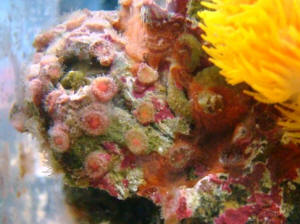 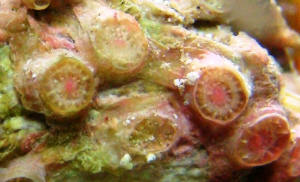
|
|
ID help -- 12/08/10
Season's Greetings, Crew.
<Dan>
Would you mind taking a look at these two little beasts?
<Not a'tall>
The anemone in the 2d photo was listed as a BTA, but I have
suspicions that my LFS is a little loose with their IDs. I have
looked in your ID section, but they all start to look alike after
a few hours. What do you think? I have never seen the tips bubble
up, even though it has grown steadily in the 3 months I have had
it. I feed it krill (~ 1.5") soaked in Selcon, and the
Maroons never leave it. Just wish I knew for certain what it
was.
<Mmm, most likely is Entacmaea... doesn't have to be
"so bubbly", and can/will likely change w/ time... And
the fact that your Premnas as so enamored of it...>
The coral looks to me to be a Montipora variety, but it has
larger polyps on it, and appears to have most of them on/near its
edges. I have a beautiful purple/green M. capricornis on the
other end of the tank, but it obviously does not have this polyp
configuration. Can you point me in the right direction
please?
<This is a Dendrophylliid... a Turbinaria species, likely T.
reniformis>
By the way, thanks for the recent assist with an H. rigida ID. I
purchased it, and it is now looking great, eating, and (to the
best of my knowledge) thriving on top of my reef stack under the
10K HQI.
All the best,
Dan
<And to you, Bob Fenner>
|
|
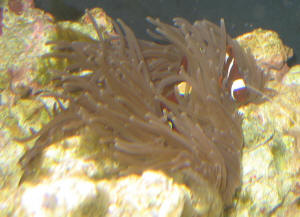 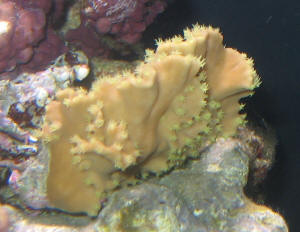
|
|
ID 11/10/10
Hi Crew,
Is this a Merulina or Platygyra?
It was listed as Merulina but I hope it is not.
Thanks,
Sam
<Not the former, possibly a Platygyra sp. Bob Fenner>
|
|
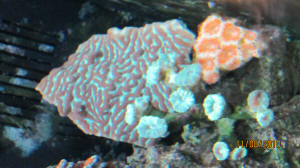
|
|
Help in coral identification -
10/22/10
Hi there,
<Howdy>
Recently got a coral from the LFS who said it was a Fox
coral,
<Nemanzophyllia, N. turbida...>
but deflated
because of shipping.
<Mmm, does happen>
Read that these are the grumpiest of corals
<?>
and even if you fart in the same room they will deflate for days.
Had read that they are good beginner corals and also not
aggressive at all. Have placed it by the side of a clam and it
still is deflated. Wanted to know whether it is actually a fox
coral
<Appears to be, but bleached...>
or some type of open brain coral. There are small pin point
mouths on the valleys and the skeleton on the sides is fine and
needlelike. No visible tentacles are observed. Just help me out
on the identification.
Cheers,
Vijay.
<And you, Bob Fenner>
|
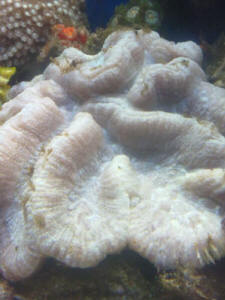 |
|
Coral ID help 9/6/2010
Hi there, thanks in advance for the assist, you guys and gals are
awesome.
<Howdy Kev>
I have this coral frag and I was told it's a Hydnophora.
However, after some research on Hydnophora and family
Merulinidae, I'm not sure. The best I could come up with is a
massive *Hydnophora exesa*. Do you guys agree or
is this something else entirely?*
<I do think this is a good guess>
*
Also, is there a good visual guide to coral identification on the
internet somewhere?
<Mmm, yes... my fave: Asira... Mmm, seems the Sara's site
is having troubles currently... Or Jake Adam's
http://coralidea.com/
Bob Fenner>
Thanks
Kevin*
|
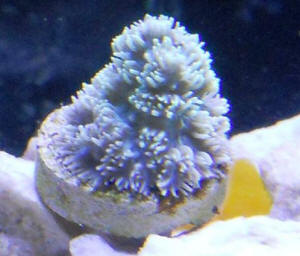 |
|
Scler ID... Fav and Dend - 8/17/10
Dear Bob n crew,
<Hello Blesson>
Greetings!
<Salutations!>
First of all thank you for this awesome site! Has helped me and
my friends in our fishkeeping immensely and changed a whole lot
of our methodology in the hobby. Well I'll try to keep this
mail short to lessen your burden.
<Yay!>
I received 2 corals from a friend and so far I think one is a
Favite of some sort,
<This is a Favia -- notice the individual corallites that do
not have shared walls? I.D. to species level is impossible here,
you would need a bleached skeleton & a copy of Veron's
works w/ a microscope to be sure>
and the other a Turbinaria.
<Yes>
I was thinking it could be a T. frondens or a T. patula or even a
T. peltata.
<I think this is T. peltata.>
Just not sure though. I have obviously done my fair share of
reading and preparation for these two corals (since the last two
months!).
<Great! These are both excellent choices, hardy and
beautiful>
It would be of immense help if you kind folks could help me
identify these specimens, and also let me know if you spot any
bleaching or any such problems from the pictures.
<These look ok to me, a little light in colour but that could
be the pictures. With good care they should be fine>
Hope the pics are not too big.
<they are ok>
The Favite doesn't seem to be acclimatised as of yet as
I've not seen its feeding tentacles or the sweeper
tentacles.
<I've had one for three years + and not seen them either,
but it's grown, albeit slowly>
And the Turbinaria extends its polyps but not as much as I've
witnessed in some of the Turbinaria pictures.
<This looks fine to me>
And just letting you guys know that I've been reading the
dailies regularly for almost six months now and just love all the
info!
<Great!>
Any ways, thanks again in advance for your help. My regards to
Bob, Salty, Neale, Lynn, Chris and the rest of the gang.
Cheers, Blesson.
<Thanks, Simon>
|
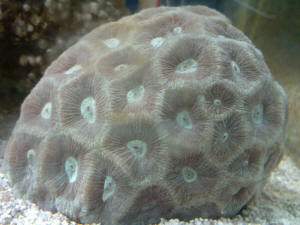 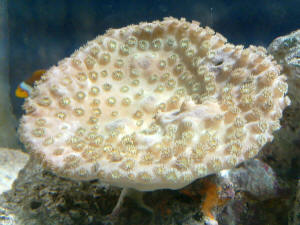 |
|
Re: Favia and Dendrophyllid 8/25/10
Good day ! Bob and crew,
<Hello Blesson! Sorry this has taken me a while to get back to
you, I thought I had checked my in-box and it turned out I had
not>
Hope this mail finds everyone in the best of health and spirits
:)
<Yes thank you! My nurse says that my lungs are at 132%
capacity!>
Well my main reason for writing in today is to confirm the id
given for one of my corals. Simon identified this specimen I am
talking about as a Favia sp. No offense Simon but I was surfing
through a reputed e-tailer's website and they had a picture
that resembles the coral I have almost in every way except for
the colours. It was named reverse prism Goniastrea closed brain
coral.
<Mmmm, no. A Goniastrea would have shared walls between the
corallites, and I believe that each corallite on your coral has
it's own walls. This is THE defining characteristic. Check
Borneman or Veron's books for more reliable I.D methods than
e-tailers, who often do not know which animals they are selling.
This article describes how to I.D these http://www.reefs.org/library/aquarium_net/1097/1097_1.html
'the corallites are separated from each other and are
distinct oval, round, or amoeba-shaped structures which may be
touching but never fusing'. Another possibility could be a
Favites, although distinguishing these and Favia apart is
sometimes difficult as they can be very similar indeed>
And none of the pictures on WetWeb look like what I have, under
the category Favia. Hence the doubt :(. Don't mean to
challenge Simon's knowledge or anything like that, just
making sure what I have is a Favia indeed. Plus I find the info
on Goniastrea care on WetWeb is pretty scanty.
<Is still a Faviid, and it's care is pretty much the same
as the others, so no worries there.>
Could you please be kind enough to re-direct me to those
pages.
<Try here. http://www.wetwebmedia.com/faviidsysfaqs.htm
>
Thanks,
Blesson.
<No worries, Simon>
|
|
Unusual Coral Frag Growth 6/18/10
Hi Bob,
<James>
I've fragged a few pieces from a coral I've grown from a
large (8+ inch spread), what I believe to be a variation of a
Bird's Nest Coral which was given to me as a frag.
<? this... in the pic?>
Every frag I've "replanted" from this coral grew
proportionately (base size to finger size). I felt that the
growth of this particular frag was unusual. There are a few bumps
that obviously are going to be future fingers, but I found it odd
that after six months, just the base continues to spread with no
finger growth. Just wondered what your thoughts are on this. See
attached pic.
Cheers,
James
<Judging from the size, uniformity of the corallites, I'd
say this was likely a Porites species. B>
|
 |
|
|

